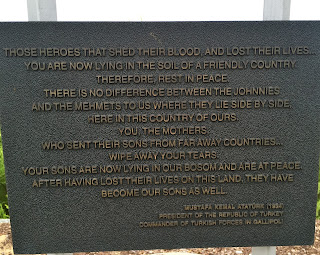 |
The Striking memorial at Mort-Homme
The legend - Ils n'ont pas passe
(They did not pass) |
Having decided to change tactics, the Germans proceeded with customary efficiency to prepare their two pronged pincer attack on the (somewhat flattened) Verdun salient. Their hard won narrow central advance on the right bank of the Meuse was coming under artillery pressure from the French defensive positions on the the left bank. These position were a short term target for the north western pincer. However the main prize, analogous to Douaumont heights on the right bank, was Mort-Homme -Dead Man's Hill. Considering what transpired there, the hill was given its title with eery prescience in the 19th century, named for a traveller who died there, lost in the winter snow. 1916 saw horrors far worse than hypothermia.
Mort-Homme is the highest part of the ‘Goose’s Crest’ of wooded hills running
westwards from Forges and Samogneux. Capture of this would enable almost
uninterrupted progress for the four miles southwards to Charny, to the
outskirts of Verdun itself. It would also clear the left bank of the French artillery
positions that had restricted the initial right bank thrust of the Germans.
 |
| Diagram of the Meuse West Bank |
To
take Mort-Homme was a major challenge, and would mean taking the whole Goose’s
Crest. Only two approaches were possible, either from the north between Forges
and Bethincourt, or from further west via Avocourt, and the woods to the west
at the base of Mort-Homme.
On the eastern side, they made simultaneous assaults on
the villages of Douaumont and Vaux from 4th March. At this stage the main purpose was to divert reinforcements that might be
moved to the Mort Homme sector. For a further two days Germans extended the bombardment
to the whole north west sector, right round to the Argonne. Then on the 6th,
the guns stopped and two German divisions stormed the Forges glen.
As previously, the French fell back in an
ordered withdrawal supplemented by some fierce counterattacking. Corbeaux Wood
provided a good example of the fighting for Forges and Regneville. It was taken
and retaken several times during 6-10th March. Close by to the south
west Cumieres Wood and village were the site of three weeks brave resistance by
poilus to the massed German infantry attacks, winning great praise from Joffre
as “the men who barred the road to Verdun”.
On the 9th March the full pincer force fell on the north east and centred on Vaux. This was a major
effort to turn the French line, and they added to it with further attacks from
due east through Damloups, Eix and Manheulle. All attacks were repulsed,
forcing the Germans to shift their attack back to the north west. Up to 14th
March, they made their major effort to take Mort-Homme. The French defensive
lines were squeezed to a narrow salient with the village of Bethincourt at its
apex. Over three days both sides fought each other almost to a standstill, but
the French held on. One more major attack on Vaux was made, and repulsed,
before the second phase came to a close, 22 days since the German ‘4 day
campaign’ to occupy Verdun had begun.
The remaining route to take Mort-Homme
from the west had not been been seriously attempted, and this now became the German
focus. Up to this point both sides had suffered
severely, their casualties almost equal, and Falkenhayn was nowhere near his first
objective, or his overall plans for the campaign. Nor had there been the
expected Allied counter-attack from further west and north on the main front, so that the
German reserves were barely occupied.
The new and final phase of these efforts to
batter their way through the French defences began from the west, with a three
days bombardment up to 20th March. On the afternoon of 20th,
the Bavarian infantry, using flamethrowers, advanced from the Avocourt –
Malancourt line through the Avocourt wood. They established a redoubt there before
pressing on to storm the slopes of Hill 304 next to Mort-Homme. Over 2 days of
relentless fighting they reached them, and almost pinched out the salient of
the village of Malancourt. There was a lull for 2-3 days while both sides
recovered, before the final efforts of the Germans resumed. On the left bank
they managed to take Haucourt and drive the French from Bethincourt, but their
overall advance was limited to one mile along a front of six miles, and they
could not penetrate beyond the lower northern slopes of Hill 304 and
Mort-Homme. They eventually took Hill 265 to the west, but could not gain Hill
295 to the east. Pushing again, but from due west, they pounded their way
through Malancourt Wood and the village of Avocourt. On the 9th
April that reached as far as the north eastern slopes of Mort-Homme and were
encroaching on three sides. Petain’s rallying cry came the following morning:
“April
9th was a glorious day for our armies, the furious attacks of the
soldiers of the Crown Prince broke down everywhere. The infantry, artillery,
sappers and aviators of the 2nd Army vied with one another in
valour. Honour to all. No doubt the Germans will attack again. Let all work and
watch, that yesterday’s success be continued. Courage! We shall beat them!”
and indeed the last German efforts here ran
out of steam on that day.
 |
The severely battered Fort Vaux in
March 1916 |
On the east bank, similar desperate
assaults had continued towards Vaux. They took the western side of the village,
and were able to advance some way towards the plateau of Douaumont, but it was
a narrow route that soon became congested with weaponry and increasing numbers
of dead and dying, and their advances ground to a halt. Their losses were very
high, and spelt the end of the third phase of the broad assault. both pincers had been blunted.













